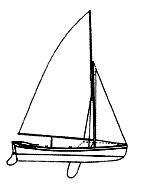Exploration 18
Daysailer
Designed by Jean Grenier, the 18 is in the style of traditional British daysailers. The sheer spring is sprightly with the freeboard at the sternpost equal to the freeboard at the stem. Do you ever wonder why sheer spring, rather than straight, is traditional? I would hypothesize that the ends were lifted originally to help keep the boat dry. The freeboard at the midsection was lowered to help get rowers closer to the water for more efficient oar power. Practical considerations have led to attractive solutions in the 18.
The hull form might have been more symmetrical fore and aft if this boat was more faithful to the traditional models, but we have learned over the years that symmetrical hull shapes tend to be slow. Mr. Grenier has pushed the maximum beam at the waterline aft and has filled out the stern to help move the longitudinal center of buoyancy aft. It's a very pleasant hull shape. Note that there is a centerboard trunk that houses a short, galvanized iron, low-aspect-ratio board with an elliptical tip. The boat weighs 680 pounds, giving us a D/L of 59.86. Remember that D/Ls will always be on the low side for unballasted boats.
The 18 is rigged with a sliding gunter rig. That sounds pretty salty. The photos show a rig with the gunter near vertical; the mainsail's overall shape is not unlike that of a dinghy with a bendy mast. This rig was probably developed when someone noticed that the more vertical the gaff, the more efficient the sail. The gaff rig eventually evolved into this sliding gunter rig. It's quite effective-looking. The big advantage of the sliding gunter rig is that it reduces the required height of the mast for a given sail area, making the mast easy to stow when rowing. The spars are spruce. The SA/D of this design is 35.58 without crew and, assuming a total crew weight of 400 pounds, it is 26.14.
This dinghy is built with a fiberglass hull and has a stainless steel grounding shoe running the full length of the straight keel. This is to prevent beaching damage. There are foam-filled flotation tanks placed so that the 18 will float level if swamped. There is a bilge pump fitted alongside the centerboard trunk. The interior detailing is all done in mahogany marine plywood, giving the 18 a very warm and traditional look. A wooden rubrail, breast-hook, fanny-hook and caprail complete the picture.
This is exactly the type of boat I would want to send my kid off in for the summer. I think an extended cruise in a boat like this would teach wonderful seamanship. That was the type of experience I dreamed about at 15 years old. There is an optional boom tent available that turns the cockpit into a stateroom. What more could you ask for?

Comments